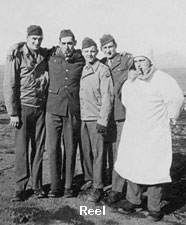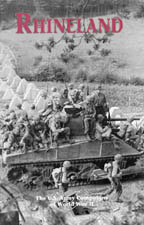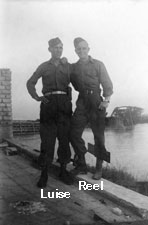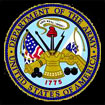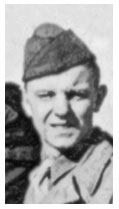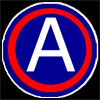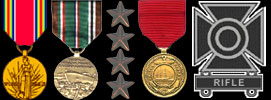| North
High School Wall of Honor Russell Edward Reel Class of January, 1943 |
 |
|||||||||||||||||||||||||||||||||||||||||||||||||||||||||||||||||||||||||||||||||||||||||||||||||||||||||||||||||||||||||
| Research done by Claradell Shedd, Class of 1953. | ||||||||||||||||||||||||||||||||||||||||||||||||||||||||||||||||||||||||||||||||||||||||||||||||||||||||||||||||||||||||||
| Russell Edward Reel | ||||||||||||||||||||||||||||||||||||||||||||||||||||||||||||||||||||||||||||||||||||||||||||||||||||||||||||||||||||||||||
| Russ was a member of North High's class of January, 1943. His next of kin was listed as Mr. Russell J. Reel, 3927 11th Street Place, Des Moines, IA. Russ's service number was 37661848. | ||||||||||||||||||||||||||||||||||||||||||||||||||||||||||||||||||||||||||||||||||||||||||||||||||||||||||||||||||||||||||
|
||||||||||||||||||||||||||||||||||||||||||||||||||||||||||||||||||||||||||||||||||||||||||||||||||||||||||||||||||||||||||
|
*Camp Pendleton, VA ***Artillery The financial climate of the 1920s and 1930s delayed the deployment of such an improved artillery system. However, sufficient funding was available to allow innovative Artillery and Ordnance officers to continue experimenting with new gun designs and doctrine. As a result, when the Army began to expand, much of the background work to modernize the artillery was already complete. Designs had been completed and prototypes developed and tested for most of the guns and howitzers that were to see service during the war (the opposite of the situation in the new Armor Branch, where prohibitive cost had stymied design work on armored vehicle prototypes and doctrinal experimentation during the 1920s and 1930s). Divisional pieces included the M1 105mm howitzer and the M1 155mm howitzer. Both were excellent weapons, with good range and, particularly in the case of the 155mm, excellent accuracy. Other new weapons were the M1 75mm pack howitzer and the M3 105mm howitzer. Both were lightweight and could be easily broken down into manageable loads suitable for transportation by pack animal (horse, mule, or man as available) or by air, and if relatively short-ranged, were ideal for airborne forces. The M3 also saw service after 1943 in the Cannon Company of the infantry regiment. A SP version of the M1 105mm, the M7 Priest, also equipped the field artillery battalions of the armor division. Non-divisional artillery pieces included battalions equipped with these same weapons, as well as other, heavier pieces. A companion of the 155mm howitzer was the 4.5" gun (an indigenous 120mm gun was one of the few failures of the inter-war design projects). The tube of this gun was of British design, while the carriage was that of the 155mm howitzer (carriage commonality between companion guns and howitzers was one of the hallmarks of U.S. artillery designs). Unfortunately, the 4.5" -- although well liked by American artillerymen - was not a very efficient weapon for its size. The shell (also of British design) was of low-grade steel, thick-walled and with a small bursting charge compared to the shell weight. The 4.5" projectile weighed 54.90 pounds, but had only a 4.49 pound bursting charge, while the 105mm howitzer projectile weighed 33 pounds, but had a 4.8 pound bursting charge. Its range was insufficient to compensate for the relative ineffectiveness of this round and as a result it was withdrawn from service soon after the end of the war. A much more effective weapon was the M1 155mm gun, known as a "Long Tom" (an appellation with a long and glorious tradition in the U.S. artillery.) It combined long range, accuracy, and hitting power with a well designed, mobile carriage. A different 155mm gun was the M12 SP. Developed in
1942, it was an interesting amalgam of the old and the new, utilizing
the tube of the pre-war French designed GPF (Grand Puissance, Failloux),
itself developed in World War II, and the chassis of the obsolescent
M3 Grant tank. It was an experiment by the Ordnance Department that
had been turned down by the AGF in October 1943 on the grounds that
there was no requirement for it. However, in early 1944 urgent requests
from U.S. Army forces in England for a heavy SP gun resulted in 74
being rebuilt. They eventually equipped seven field artillery battalions
in the ETO and proved invaluable. An improved model, the M40, based
upon the M1 gun and M4 tank, was produced in 1944 and deployed in
limited numbers to the ETO in March 1945. Nearly all US artillery battalions were organized
with three firing batteries and a total of twelve tubes. The exception
was the eighteen-tube armored field artillery battalion and the six-tube
8" gun and 240mm howitzer battalions. A major advantage for the
American artillery was that it was fully motorized and highly mobile.
All 105mm and 155mm howitzer battalions in the ETO were truck-drawn,
although a Table of Equipment (TE) for a tractor-drawn 155mm battalion
existed. The 155mm gun battalions were almost all tractor-drawn, although
a few evidently were also truck-drawn. The 4.5" gun, 8"
gun, 8" howitzer, and 240mm howitzer battalions were all tractor-drawn,
although, again, a TE for truck drawn battalions existed. The standard
prime mover was a two-and-one-half ton truck for the 105mm and a 4-ton
Diamond T truck for the 155mm howitzers. Tractors included the M5
thirteen-ton prime movers, which were utilized for the 105mm M2 howitzer,
the 4.5" gun, and 155mm M1 howitzer, and the M4 eighteen-ton
hi-speed, full-track, heavy prime mover, which was utilized for the
3" AA gun, the 90mm AA gun, the 155mm Long Tom gun, 8" howitzer,
8" gun, and 240mm howitzer. Redundant M3 medium tank chassis,
without armament, and M31 and M32 armored recovery vehicles were also
utilized as prime movers for the heavier artillery pieces. Field artillery brigades were also created, originally to command the separate field artillery regiments and later, to command the field artillery groups. However, the brigade eventually was seen as a redundant and unnecessary additional layer of command. Most of the brigades were inactivated or were redesignated as H&H batteries and assigned to different corps and divisions. A few artillery brigades were retained and served as such, the 13th in the MTO and the 32nd, 33rd, 34th, and 61st in the ETO. In the First Army in the ETO, two field artillery groups were attached to the 32nd Field Artillery Brigade. The brigade controlled all 8" gun and 240mm howitzer battalions of the army, making it, in effect, a heavy artillery brigade. A similar, but less centralized system was followed by Third, Seventh, and Ninth armies for control of their heavy battalions. All in all, the U.S. artillery was equipped with armament that was at least as well designed as, if not better than, any other in the world. The U.S. artillery further benefited from communications equipment and a fire control system that was equaled only by that of the Royal Artillery. Individual forward observers operated close to the front lines and had access, via powerful radios and extensive telephone landlines, to a formidable array of weapons. The highly redundant signals system meant that, even when all other contact with front-line units and their headquarters was lost, the artillery communications net usually remained open. Perhaps more important, and making the U.S. artillery the best in the world, was a fire-direction system that had been develop at the U.S. Field Artillery School at Fort Sill, Oklahoma, between the wars. This was a highly refined development of the crude system Summerall had pioneered in World War I. This system permitted rapid engagements of targets, and allowed the coordination of fires of many units from many widely separated firing positions. One of the most deadly tactics employed was the time-on-target (TOT) concentration. A TOT massed fires from several battalions onto a selected target and calculated the times of flight for the shells from each battery so that they all arrived on target at nearly the same instant (a similar tactic, called a "Stonk", had been developed independently by the Royal Artillery in North Africa). Further enhancing the deadliness of the U.S. artillery was the development and deployment in the ETO in December 1944 of the new proximity fuse. Also known by its code designation of VT (for variable-time) or POZIT, the proximity fuse contained a tiny radar that triggered detonation at a preset distance from a solid object. The POZIT fuse had been intended for use against air targets (taking a heavy toll of German "Buzzbombs" in the fall of 1944). The fuse significantly simplified and enhanced the lethality of air bursts and eliminated the need for complicated and unreliable time fuses. Although US artillery was second to none in the war, problems with ammunition supply did hamper efficiency at various periods. This problem reached its nadir during the fall of 1944, when the US artillery in Europe was reduced to strict rationing of ammunition. At one point, the artillery was limited to fewer than twenty 105mm rounds-per-day-per-gun. From 11 October to 7 November 1944, Third Army fired a total of 76,325 rounds of all types (an average of 2,726 per-day), which was less than the number fired on a single day during the Battle of the Bulge. Indeed, at the end of the Battle of the Bulge, ammunition reserves in the ETO were 31 percent of the War Department's planning levels (which were already conceded to be too low). Like the personnel replacement problem, the ammunition shortage was only truly solved by the ending of the war. Initially, the troop basis allotted by the AGF for non-divisional artillery was somewhat low, and it emphasized lighter artillery over heavier. Only fifty-four heavy and eighty-one medium battalions, compared to 105 light battalions, were authorized on 24 November 1942. However, lobbying by Generals McNair and Sommervell in 1943 resulted in an increase. On 15 January 1944 the War Department authorization had expanded to include 111 heavy and 111 medium battalions, while the number of light battalions authorized had decreased to 95. In April 1944 a review of combat experience by the Lucas Board resulted in a further expansion, with 143 heavy and 114 medium battalions authorized on 1 July 1944. Converting light artillery battalions made up most of the increased numbers, by 1 July the authorized number of light battalions was down to eighty. On 31 December 1944 the artillery reached its maximum strength. On that date there were a total of 346 battalions active, 137 heavy, 116 medium, and 93 light. On 31 March 1945 there were 137 heavy, 113 medium and 76 light battalions active, of which 307 were deployed or were about to deploy to active theaters of war. Although US artillery was second to none in the war, problems with ammunition supply did hamper efficiency at various periods. This problem reached its nadir during the fall of 1944, when the US artillery in Europe was reduced to strict rationing of ammunition. At one point, the artillery was limited to fewer than twenty 105mm rounds-per-day-per-gun. From 11 October to 7 November 1944, Third Army fired a total of 76,325 rounds of all types (an average of 2,726 per-day), which was less than the number fired on a single day during the Battle of the Bulge. Indeed, at the end of the Battle of the Bulge, ammunition reserves in the ETO were 31 percent of the War Department's planning levels (which were already conceded to be too low). Like the personnel replacement problem, the ammunition shortage was only truly solved by the ending of the war. Initially, the troop basis allotted by the AGF for
non-divisional artillery was somewhat low, and it emphasized lighter
artillery over heavier. Only fifty-four heavy and eighty-one medium
battalions, compared to 105 light battalions, were authorized on 24
November 1942. However, lobbying by Generals McNair and Sommervell
in 1943 resulted in an increase. On 15 January 1944 the War Department
authorization had expanded to include 111 heavy and 111 medium battalions,
while the number of light battalions authorized had decreased to 95.
In April 1944 a review of combat experience by the Lucas Board resulted
in a further expansion, with 143 heavy and 114 medium battalions authorized
on 1 July 1944. Converting light artillery battalions made up most
of the increased numbers, by 1 July the authorized number of light
battalions was down to eighty. On 31 December 1944 the artillery reached
its maximum strength. On that date there were a total of 346 battalions
active, 137 heavy, 116 medium, and 93 light. On 31 March 1945 there
were 137 heavy, 113 medium and 76 light battalions active, of which
307 were deployed or were about to deploy to active theaters of war. |
||||||||||||||||||||||||||||||||||||||||||||||||||||||||||||||||||||||||||||||||||||||||||||||||||||||||||||||||||||||||||
|
||||||||||||||||||||||||||||||||||||||||||||||||||||||||||||||||||||||||||||||||||||||||||||||||||||||||||||||||||||||||||
|
||||||||||||||||||||||||||||||||||||||||||||||||||||||||||||||||||||||||||||||||||||||||||||||||||||||||||||||||||||||||||
|
||||||||||||||||||||||||||||||||||||||||||||||||||||||||||||||||||||||||||||||||||||||||||||||||||||||||||||||||||||||||||
| 8/30/10. Living in Des Moines, IA. Died: 12/01/13. | ||||||||||||||||||||||||||||||||||||||||||||||||||||||||||||||||||||||||||||||||||||||||||||||||||||||||||||||||||||||||||
| Music: "Wind Beneath My Wings" | ||||||||||||||||||||||||||||||||||||||||||||||||||||||||||||||||||||||||||||||||||||||||||||||||||||||||||||||||||||||||||
| Home
|
Back/allyears |
WWI |
WWII |
Korea |
Vietnam |
Afghanistan/Iraq |
Lyrics
|
Refs/Awards |
Contact ©2025-csheddgraphics All rights reserved. All images and content are © copyright of their respective copyright owners. |
||||||||||||||||||||||||||||||||||||||||||||||||||||||||||||||||||||||||||||||||||||||||||||||||||||||||||||||||||||||||||
